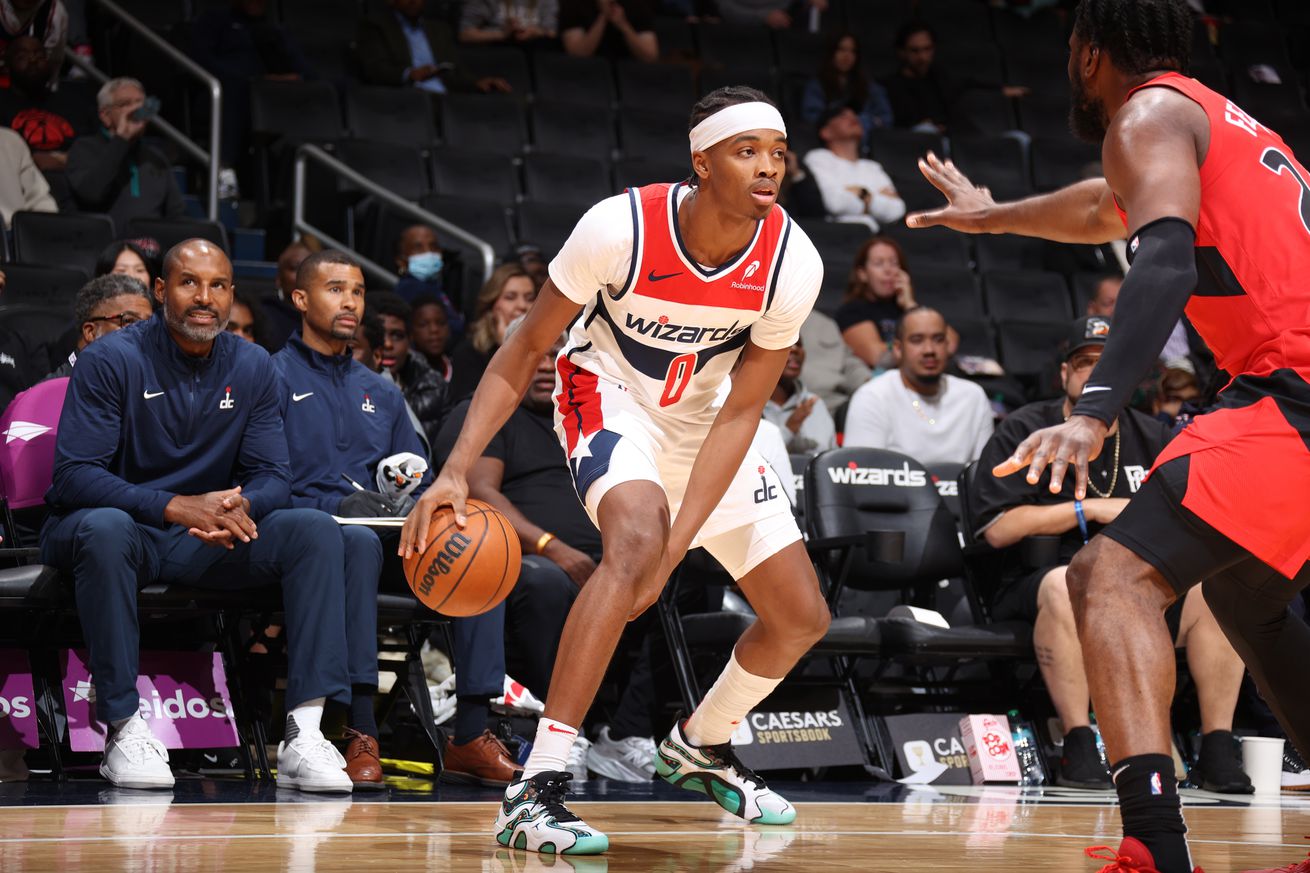
What the numbers say about Washington’s prospects this season.
The Washington Wizards’ new braintrust — Michael Winger, Will Dawkins, and Travis Schlenk — a full season and two offseasons in charge. Dawkins’ pre-training camp comment that the team is still in the “deconstruction” phase of the rebuild serves as a stark reminder of what a rebuild of this franchise entails.
This is no sugarcoat renovation. They’re razing the team beyond the studs and past the foundation — back to dirt. Back to the point where they lay a new foundation and construct something new. The task is colossal and will take time.
This summer, they made last season’s interim head coach Brian Keefe the official head coach and cleaned out the rest of the coaching staff to make space for guys with development experience. “Development” coach is industry jargon for “teacher,” which is the best model for coaching at all levels anyway. Suffice to say, I like the idea of having a staff dedicated to teaching basketball to guys ready to learn.
As befits a team with a 15-67 record, they made some offseason roster changes. Starting guard Tyus Jones departed to the Phoenix Suns on a minimum salary contract. He’ll be a strong candidate for the totally made up “Best Bargain” award.
They cut ties with Landry Shamet, who signed with the New York Knicks.
Having dealt center Daniel Gafford at the trade deadline, they needed help at center, which they addressed (for at least a little while) by signing free agent big Walking Trade Exception Jonas Valanciunas.
Their biggest non-draft move was trading 23-year-old forward Deni Avdjja to the Portland Trail Blazers for two first round picks and veteran Malcolm Brogdon. The fact that a 23-year-old coming off the best season of his career and signed for the next four years on a reasonable and declining contract was considered expendable is strong signal of Washington’s time horizon for this rebuild.
The Wizards turned the first of those picks into Carlton “Bub” Carrington, a young and promising guard whose best attribute is his competitiveness.
In addition to Carrington, who they picked 14th overall, they added second overall pick Alex Sarr, and Kyshawn George with the 24th selection.
They retained bench guys Anthony Gill and Jared Butler, and brought back Justin Champagnie and last year’s second round pick Tristan Vukcevic on two-way deals.
After trying to deal veterans for picks and young guys at the 2024 trade deadline, the team rotated the stock of veterans, who they will now try to trade to other teams for draft picks and young guys. This year’s group includes Kyle Kuzma, Brogdon, and Valanciunas. They’d likely also be willing to part ways with Jordan Poole, if Poole can play well enough to entice another team to give up something of value to get him.
Further down the list of desirable trade targets for contending teams are Richaun Holmes and Marvin Bagley III, but the right combination of injuries could create an opportunity for the Wizards to get something for one or both.
Corey Kispert belongs on the trade bait list, as well, though the first question with him is whether the team signs him to an Avdija-like contract before dealing him.
This season is not about winning games. The team won just 15 games last season, and the roster is arguably weaker with the departures of Avdija and Jones. What they provided isn’t impossible to replace, however, and it’s possible that the combination of improving players (Bilal Coulibaly and Poole are prime candidates) and precocious newcomers (Sarr and Carrington) could be an upgrade.
That said, the Wizards’ braintrust wants a high pick in what appears to be a strong 2025 draft class. To maximize their lottery odds, they’ll want to finish with one of the league’s three worst records. In other words, they’re likely to end the year with fewer than the 15 wins they compiled last season.
2024-25 Player Forecasts
These forecasts use my Player Production Average (PPA) metric. PPA is an all-around rating tool that credits players for things they do that help a team win, and debits for things that don’t — each in proportion to how individual players contribute to NBA wins and losses. PPA is pace neutral and includes accounting for defense, role and the level of competition a player faces when he’s on the floor. In PPA, average is 100, higher is better, and replacement level is 45.
Below are results from four different forecast approaches: one using my Statistical Doppelgänger Machine (DOPP), another using a predicted PPA based on an age-adjusted career curve (dubbed MILK in honor of sports economist David Berri), a simple weighted three-year average PPA (SIMP) and another that applies an aging adjustment to that weighted three-year average (SAGE).
I estimated minutes by using a weighted average of each player’s minutes in recent seasons, as well as my best guess at each player’s role in the team’s rotation this season.
Key
- Last PPA = PPA last season
- DOPP PPA = forecasted PPA using the Doppelgänger approach
- MILK PPA = forecasted PPA using last season’s PPA and an age adjustment
- SIMP = forecasted PPA using a “simple” weighted three-year average PPA
- SAGE = forecasted PPA using a “simple” weighted three-year average and an age adjustment
- BLEND = forecasted PPA using an average of the four approaches above
The *** represents my best guess of which forecast is most probable for each individual.
Kyle Kuzma
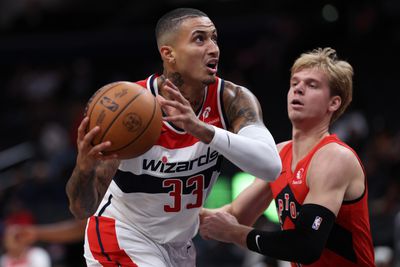
Photo by Patrick Smith/Getty Images
At his best, Kuzma looks awesome — size, mobility, skills. For all that size, mobility, and skills, he’s struggled throughout his career to convert possessions into points. Last season, his offensive efficiency was 10.8 points per 100 possessions below league average — the second worst mark of his career. He’s never been closer than -3 points per 100 possessions relative to average.
Maybe he could be more efficient by scaling down his usage, but I doubt it. His subpar efficiency has been evident throughout his career, even when playing with defensive attention magnets like LeBron James, Anthony Davis, Kristaps Porzingis, and Bradley Beal.
His game-to-game performance has broad variance, which is a stat goober way of saying he’s inconsistent. His year-to-year performance varies little, however. Given his year-to-year consistency and the fact that he’s entering his age 29 season, there’s little reason to think he’ll make a leap in production this year (or any year).
Kuzma’s statistical doppelgängers suggest a potential peak of 135, but the average peak of that group was 26-27. The best season of Kuzma’s career was 2021-22 when he was 26. His PPA went right back to the “a bit below average” career norms in the two seasons since.
- Last PPA: 98
- DOPP PPA: 105
- MILK PPA: 92***
- SIMP PPA: 98
- SAGE: 96
- BLEND: 98
Jordan Poole
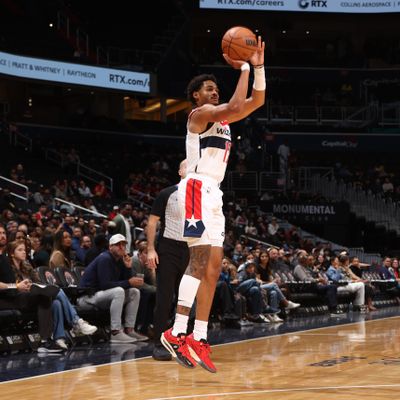
Photo by Kenny Giarla/NBAE via Getty Images
The first 57 games of last season were catastrophic for Poole. The last 21 weren’t bad. The Official Narrative was that Poole was hobbled somehow by sharing the floor (and ball handling chores) with Tyus Jones, and that he improved once he was separated from Jones and given an on-ball role. That narrative might even be correct. Maybe.
NBA tracking data showed that Poole’s offensive-end touches per minute declined when he moved to the bench and played less with Jones, meaning he had the ball less and played better.
Maybe his production takes a jump with a season in Washington under his belt, plus a full training camp as the team’s lead ball handler. How big a jump he might make is a real question. His best season was a 123 PPA, which is a bit above average. Players most like him in NBA history tended to peak low and early. My guess is that his performance will tick up but won’t take a major leap.
- Last PPA: 67
- DOPP PPA: 71
- MILK PPA: 69
- SIMP PPA: 78
- SAGE: 80
- BLEND: 75***
Bilal Coulibaly
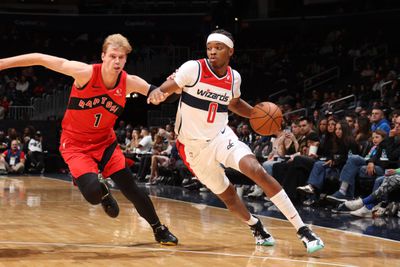
Photo by Stephen Gosling/NBAE via Getty Images
I was 100% on board with trading up a spot in the 2023 draft to select Coulibaly. I think he has tremendous potential and could turn out to be great. One of his top 10 statistical doppelgängers is Giannis, which would be nice.
All that said, I was underwhelmed by his rookie year. His defense was decent, and he had promising flashes, but he also spent a lot of his court time not really involved in the offense. His possession usage rate was an anemic 14%, which was low — even for a teenage rookie being eased into the league. As I wrote a few times last season, the dividing line for teenaged rookies was about 15%. Below that mark, no one developed into a high-quality player.
How significant is that one percentage point? I’m not sure, and I’m hoping it’s insignificant.
That out of the way, the Wizards have said they consider Coulibaly to be a big guard (he reportedly grew to 6-9 and added 10 pounds of muscle since last season). If they believe their own words, it’s time to give him the ball and let him start making decisions.
This is not a case of being impatient. Giannis, for example, had a low 15.5% usage rate as a 19-year-old rookie. In year two, it was 19.4%. In year three, 22.2%. In year four (age 22), it jumped to 27.8% and Giannis posted the first of eight consecutive (and counting) 200+ (elite) PPA seasons.
The Wizards should want Coulibaly to significantly outperform any of the forecasts below. Giannis went from 59 as a rookie to 103 in year two. If Coulibaly can crack 90, it would be reasonable to think he has star potential. If he follows a more “normal” progression, he’d still be a useful player, albeit not an elite performer who can anchor a title contender.
- Last PPA: 49
- DOPP PPA: 67***
- MILK PPA: 54
- SIMP PPA: 49
- SAGE: 54
- BLEND: 56
Jonas Valanciunas
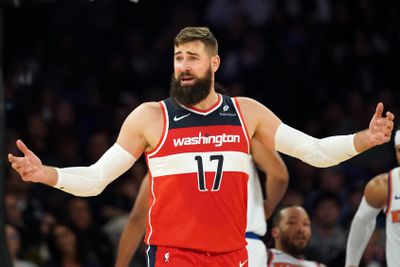
Photo by Evan Bernstein/Getty Images
Valanciunas is a slow, plodding, aging, and defensively challenged big man who still does a bunch of stuff needed to win games like set screens, convert possessions into points, and grab loads of rebounds.
He’ll likely start for the Wizards and won’t miss many games, unless he’s still on the roster towards the end of the year, and they’re sitting veterans to avoid winning games to protect their health. I mean, a bruised hair strand could get infected. Can’t be too careful.
Anyway, Valanciunas has been both good and healthy throughout his career, and while he’s getting to an age where players can hit a production cliff, there isn’t much reason to think he’ll reach that cliff this season. Most of his historical comps were quality players who aged well.
In other words, the Wizards will seek to accentuate his production early and trade him for draft picks and young players by the deadline. Enjoy him for as long as he’s on the team — he’s an entertaining mixture of sledgehammer physicality and basketball skill.
- Last PPA: 157
- DOPP PPA: 139
- MILK PPA: 138
- SIMP PPA: 148
- SAGE: 130***
- BLEND: 139
Malcolm Brogdon
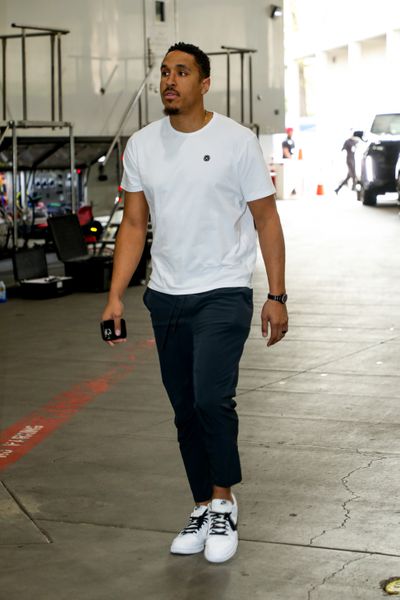
Photo by Cameron Browne/NBAE via Getty Images
Brogdon has been a great person and a good-to-very-good player in the NBA for eight seasons. Entering year nine, the Wizards have to bank on the “great person” contributing to their rebuild — at least to start the season — because he’s sidelined after undergoing surgery to repair a torn ligament in his right thumb.
The latest injury is part of a long-standing pattern with Brogdon. He’s missed significant chunks of seven of his eight seasons. Last year, he managed just 39 games with the Portland Trail Blazers.
When he can play, he’s likely to be pretty good. He was last season. Don’t expect improvement, however — at his age and with his injury history, the best that can be hoped for is “about the same.” The Wizards need him to return from injury and get back on the floor long enough to entice a contender to trade for him.
- Last PPA: 125
- DOPP PPA: 116
- MILK PPA: 111
- SIMP PPA: 127
- SAGE: 112
- BLEND: 116***
Corey Kispert
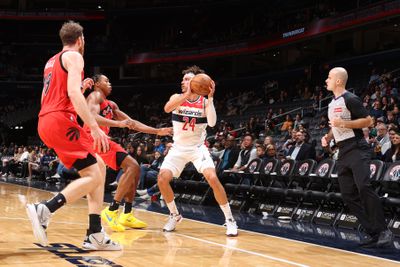
Photo by Stephen Gosling/NBAE via Getty Images
The numbers say Kispert has reached the “what you see is what you get” stage of his career. He can shoot, attack closeouts and convert at a high rate (as long as there isn’t a big around the rim), and he’s a decent cutter and general off-ball mover. Defense is an adventure. Rebounding and playmaking are nearly non-existent by NBA standards.
That’s not to say Kispert is bad — he’s not. It’s more like what Matt Modderno described in one of his excellent Bleav in Wizards post-game shows: unlike some players who could be the 7th or 8th man on a good team and the second or third man on a bad team (the Wizards have a few of these guys), Kispert is basically a 7th or 8th man on any team.
Players most like Kispert throughout NBA history have tended to peak early (age 24-25) and low (average peak PPA: 99). Kispert is 25, and his best season was two years ago (PPA: 95). I’d be mildly surprised if he finishes the season in Washington.
- Last PPA: 80
- DOPP PPA: 67
- MILK PPA: 83
- SIMP PPA: 85
- SAGE: 88
- BLEND: 81***
Alex Sarr
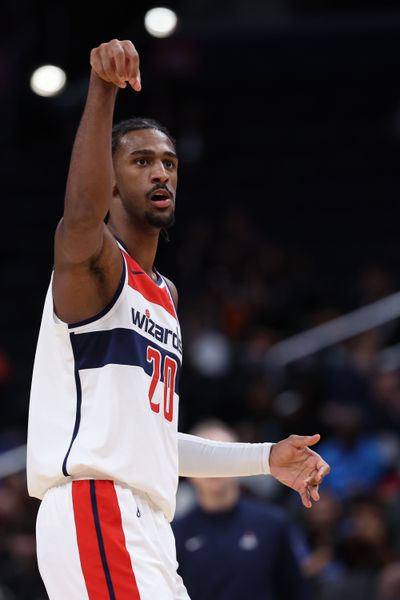
Photo by Patrick Smith/Getty Images
The prize for the worst season in franchise history was the second overall pick and the opportunity to pick French forward/center Alex Sarr. Pay no attention to his abysmal summer league performance — he was the highest rated prospect in my stat-based pre-draft analysis, and all the reasons for that (size, athleticism, solid production in a good professional league) remain.
My forecasting approach for rookies involves analyzing the recent history of players picked in the same vicinity. In general, players picked in the early part of the lottery play a lot and reasonably well. Of the 15 players considered in Sarr’s forecast, nine got at least 2,000 minutes as rookies. Only James Wiseman was unable to crack 1,000.
Actual production varies wildly. The least productive player in the Sarr forecast cohort was Scoot Henderson, who posted a 24 PPA in 1,765 minutes. The most productive was Chet Holmgren (after missing an entire season with a foot injury), who had a 159 PPA in 2,413 regular season minutes.
That’s basically the anticipated range for Sarr — horror-show awful to borderline All-Star. The forecast predicts the middle, which would be awesome for the Wizards. Assuming a normal career trajectory, a 94 PPA for a teenage rookie would suggest someone who peaks around a 250 PPA and sustains around that level for 8-9 seasons. That’s the level of an MVP candidate.
Don’t get too nuts with career forecasts — Sarr hasn’t played game one yet.
FORECASTED ROOKIE PPA: 94
Bub Carrington
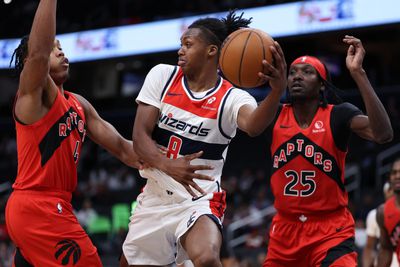
Photo by Patrick Smith/Getty Images
The good news is that Carrington’s approximate draft slot is historically where good players sometimes slide. Carrington’s forecast cohort includes Alperen Sengun, Jalen Duren, Cole Anthony, Mark Williams and Aaron Nesmith.
What would be bad news for most teams is a feature for the Wizards — non-bigs selected in this range usually take a few seasons to become quality role players. Washington, of course, has oceans of time to wait.
As is the case with most draft slots, there’s wide variance in Carrington’s forecast group. At the high end is Sengun, who produced a 149 PPA in 2,046 minutes as a rookie. (Sengun did have a top five rating in my stat-based pre-draft evaluation, just saying.) At the low end, take your pick between Romeo Langford’s 11 PPA in 370 minutes or Sekou Doumbouya’s 12 in 754 minutes.
Worth mention, my pre-draft evaluation had Carrington with a second round grade. Also worth mention, that was true of Cole Anthony, who was selected 15th overall in 2020 and has become a good backup guard.
FORECASTED ROOKIE PPA: 57
Marvin Bagley III
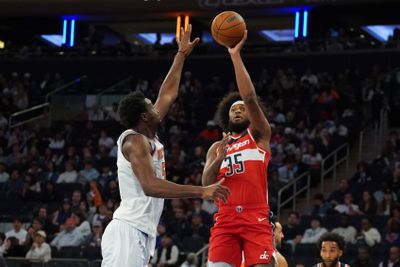
Photo by Evan Bernstein/Getty Images
When making forecasts in previous years, I had to make myself stop at 10 players. Perhaps yet another signal for what kind of season is coming: this year, I felt pretty well stuck after Carrington. Lots of options for spots nine and ten, but none of them are remotely appealing.
I chose Bagley for the ninth spot in the rotation because someone has to get backup center minutes, and it might as well be a somewhat younger player with ability who’s always getting hurt. I figure Sarr will probably get minutes at center too, so I’m not including both Bagley and Holmes in the rotation.
With all that out of the way, the thing with Bagley is the constant injuries. When he plays, he’s been pretty good, at least on the offensive end. He’s just never healthy. His career high in games was the 62 he played as a 19-year-old rookie. His second highest: the 50 he played last season with the Detroit Pistons and the Wizards.
It’s telling that the Detroit Pistons, which squeaked past the Wizards for the NBA’s worst record last season, were willing to trade him to Washington for effectively nothing.
- Last PPA: 123
- DOPP PPA: 99***
- MILK PPA: 127
- SIMP PPA: 115
- SAGE: 119
- BLEND: 115
Jared Butler
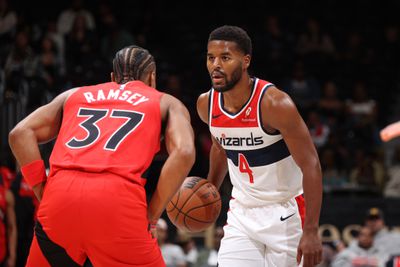
Photo by Stephen Gosling/NBAE via Getty Images
I’m not sure Butler will actually be the 10th man, but they’ll need another guard while Brogdon is recovering from thumb surgery and then when Brogdon is (probably) traded. So there’s a chance.
Butler has the makings of a solid backup guard. He’s tough and competitive and tries to make plays, though he does get out of control sometimes.
- Last PPA: 61
- DOPP PPA: 71***
- MILK PPA: 65
- SIMP PPA: 67
- SAGE: 71
- BLEND: 69
Kyshawn George
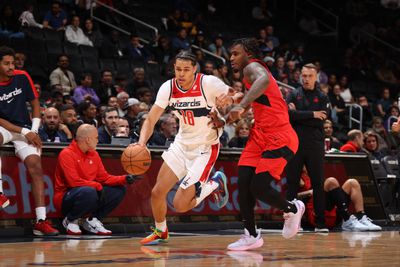
Photo by Stephen Gosling/NBAE via Getty Images
Because I figure there will be interest, I also ran a forecast on the third rookie. He’s unlikely to play enough minutes at sufficient quality to add to the team’s win total this season. That said, he could get some wing and forward minutes.
Players picked in his range tend to play little and not well. My pre-draft analysis had him rated as a late second round pick. Presumably the Wizards know and saw things that I don’t/didn’t. Even so, he’s probably a few years from being a contributor.
FORECASTED ROOKIE PPA: 50
2024-25 Prediction
Gone are the days of “contending for the playoffs” and other nonsense. The team is going to lose most of their games this year, and they’re doing it on purpose. Not in the sense that players and coaches are dogging it, but as a result of a strategic decision to shed the aging pretty good players and rebuild with youngsters who might be among the game’s elite players someday.
Those pretty good players could have kept Washington on the postseason periphery for a while longer. The young players, some of whom are not yet on the roster or even in the NBA (or even in college or an overseas league yet), may be able to bring the Wizards into title contention in a few years.
That’s the plan and the hope, and it might even work. Tanking as part of a rebuild is riddled with pitfalls and trapdoors. But it’s different from what the Wizards were doing, which was failing anyway.
Last season, I wrote that being in the bottom three was probable. This year, it’s a certainty. The big draft prizes are waiting, and they’re committed to getting one of them.
Here are their forecasted wins using the approaches described above:
- DOPP: 14.5
- MILK: 14.3
- SIMP PPA: 15.8
- SAGE: 14.5
The BLEND approach predicts 15.5 wins.
If everyone reaches their best-case forecast, the team could get to 31 wins. In an “all peaks” scenario (in which everyone reaches their career-best level), I estimate 35 wins. If the entire roster reached either their forecasted peak or their previous career peak (whichever is higher), they might get to 38 or 39 wins.
My prediction is essentially the same as last year: they’re going to lose a ton of games, trade veterans for young players and future picks, and wind up with a top three pick in the 2025 draft.
Final Prediction: 14-68 and 15th in the East.
